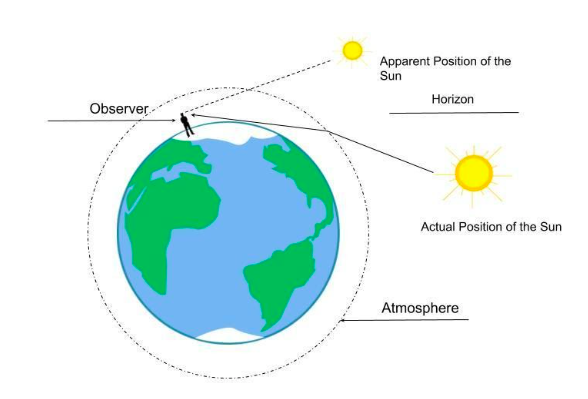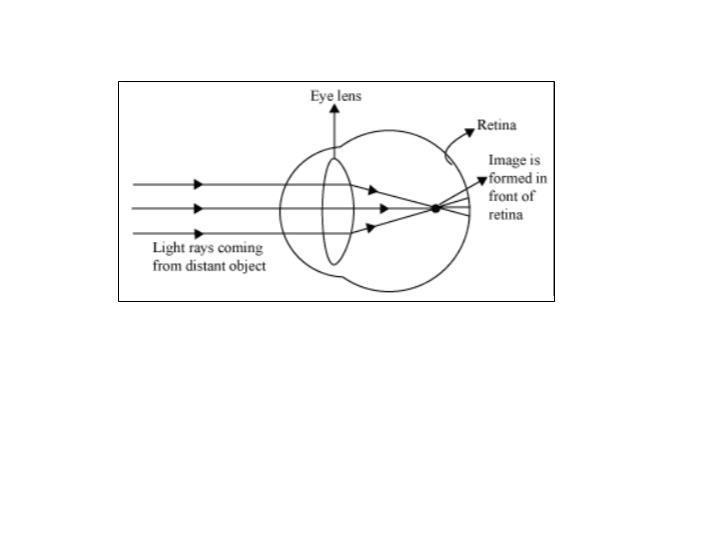
Explain the following:
(i) Atmospheric refraction and advanced sunrise
(ii) Tyndall effect
(iii) Draw the ray diagram of an eye suffering from shortsightedness
Answer
515.4k+ views
Hint:Most of the scientific terms can be easily defined if one pays enough attention to the name of those terms. For example, here in our case we have a term called ‘atmospheric refraction’, we know that the word refraction refers to bending of a wave (usually a light wave) which changes its direction. So we can simply define atmospheric refraction as bending of light while passing through the atmosphere.
Complete step by step answer:
(i) Atmospheric Refraction: The phenomenon of the deviation of light or other electromagnetic waves from a straight line while passing through the atmosphere because of the variation in air density with respect to the variation of height.

Advanced Sunrise: To an observer on the earth the sun appears two minutes before the actual sunrise. This early appearance of sun is because of the atmospheric refraction of light rays emitting from the sun. So advanced sunrise can be defined as the phenomenon of early appearance of the Sun due to the atmospheric refraction of the Sun.
(ii) Tyndall Effect: When light passes through a colloid it is scattered by larger colloidal and the beam becomes visible. This phenomenon of scattering of light by colloidal particles when it passes through a colloid is known as Tyndall effect.
(iii) Ray diagram of an eye suffering from shortsightedness: When an eye is unable to relax its eye lens up to a certain extent to form the image on retina and disables a person to focus on far off objects clearly such a situation causes shortsightedness or nearsightedness. The following figure shows a ray diagram of an eye suffering from short sightedness.

Note:
-The term short sightedness is also known as myopia.
-In Tyndall effect the intensity of scattered light depends on the density of the colloidal particles as well as the frequency of the incident light.
Complete step by step answer:
(i) Atmospheric Refraction: The phenomenon of the deviation of light or other electromagnetic waves from a straight line while passing through the atmosphere because of the variation in air density with respect to the variation of height.

Advanced Sunrise: To an observer on the earth the sun appears two minutes before the actual sunrise. This early appearance of sun is because of the atmospheric refraction of light rays emitting from the sun. So advanced sunrise can be defined as the phenomenon of early appearance of the Sun due to the atmospheric refraction of the Sun.
(ii) Tyndall Effect: When light passes through a colloid it is scattered by larger colloidal and the beam becomes visible. This phenomenon of scattering of light by colloidal particles when it passes through a colloid is known as Tyndall effect.
(iii) Ray diagram of an eye suffering from shortsightedness: When an eye is unable to relax its eye lens up to a certain extent to form the image on retina and disables a person to focus on far off objects clearly such a situation causes shortsightedness or nearsightedness. The following figure shows a ray diagram of an eye suffering from short sightedness.

Note:
-The term short sightedness is also known as myopia.
-In Tyndall effect the intensity of scattered light depends on the density of the colloidal particles as well as the frequency of the incident light.
Recently Updated Pages
Master Class 12 Business Studies: Engaging Questions & Answers for Success

Master Class 12 Economics: Engaging Questions & Answers for Success

Master Class 12 English: Engaging Questions & Answers for Success

Master Class 12 Maths: Engaging Questions & Answers for Success

Master Class 12 Social Science: Engaging Questions & Answers for Success

Master Class 12 Chemistry: Engaging Questions & Answers for Success

Trending doubts
Which are the Top 10 Largest Countries of the World?

What is transplantation in agriculture class 12 biology CBSE

Differentiate between homogeneous and heterogeneous class 12 chemistry CBSE

Why is the cell called the structural and functional class 12 biology CBSE

Who discovered the cell and how class 12 biology CBSE

What is the Full Form of PVC, PET, HDPE, LDPE, PP and PS ?




